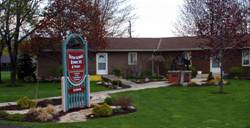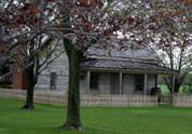Museum Background
 THE BUXTON MUSEUM, officially opened in 1967, was Raleigh Township's Centennial Project as a memorial to the Elgin Settlement, haven for the fugitives of the American system of slavery in the pre-Civil War years.
THE BUXTON MUSEUM, officially opened in 1967, was Raleigh Township's Centennial Project as a memorial to the Elgin Settlement, haven for the fugitives of the American system of slavery in the pre-Civil War years.
THE ELGIN SETTLEMENT, which was for many the last stop on the Underground Railroad, was founded in 1849. Under the guidance and supervision of Rev. William King, this historic Black settlement soon flourished, becoming a self-sufficient community of some 1200 to 2000 persons. Its first school, the Buxton Mission School, soon surpassed its neighbours in academic achievements. The settlement built around an agricultural economy included many thriving businesses owned and operated by the settlers, such a saw and grist mill, a pot ash and pearl ash factory, a brick yard, hotel, blacksmith shop, and dry goods store, among others. Part of the success of many of the early inhabitants was assisted by the fact that the employment opportunities offered by the construction of the cross-Canada railway enabled them to purchase outright the land they had settled. In addition, to their many achievements they placed a strong emphasis on quality education for themselves and their children.
FOLLOWING THE CIVIL WAR and during the Reconstruction period in the United States, many settlers returned to their homes in the south to help educate their recently emancipated friends and neighbours.
 NOW KNOWN AS BUXTON, the Elgin Settlement is one of the few remaining Black Canadian settlements still in existence since the pre-Civil War era. The co-operative community spirit has preserved the way of life with which it began.
NOW KNOWN AS BUXTON, the Elgin Settlement is one of the few remaining Black Canadian settlements still in existence since the pre-Civil War era. The co-operative community spirit has preserved the way of life with which it began.
THE FINAL SETTLEMENT SCHOOL AND LAST REMAINING SETTLEMENT CABIN, now function as part of the museum. As well, three churches built during the settlement's early years still serve this community. The road and drainage systems built by the early settlers still serve the widespread farming area.
THE MUSEUM'S PRIME CONCERN is the preservation of material and artifacts of Raleigh, with special emphasis on the history and accomplishments of the original settlers in the Elgin Settlement and their descendants. Among other things, it houses the bed, dresser, diary, and copies of papers belonging to Rev. William King as well as many other articles and papers of historical significance in this community.

SINCE 1972, RESEARCH has been ongoing. Most of the people of the Elgin Settlement have been identified and indexed. Considerable other information is now available in the museum, in forms of records and family trees. Although, the research focus has been mainly on Elgin Settlement people, it was inevitable that it would extend into other areas as well. If you are looking for your roots, we may have a piece of the puzzle.
THE MUSEUM SITE INCLUDES the Buxton Museum, S.S. #13 Raleigh (Buxton) Schoolhouse (1861), the Colbert/Henderson Cabin (1854), and the Shadd Barn (restoration to be completed in 2009). Local church cemeteries (1857) are on the grounds adjacent to the museum. Facilities include a large picnic shelter and barbecue, washrooms, a wheelchair access ramp to the museum and plenty of free parking. Of special note is the Research Area, which contains resource materials, pertaining to local history and genealogy.
THE MUSEUM IS MAINTAINED through grants from the Municipality of Chatham - Kent, the Ontario Ministry of Culture and Communication, admission fees, and donations. Descendants of those original settlers who elected to remain in Canada continue to inhabit North Buxton today. Though no longer the flourishing community it once was, it remains a vital and active Black Canadian village, which continues to remember and preserve its role and roots in North American Black history and in the history of Canada. In 1964, these descendants petitioned the Raleigh Township Council to allow them to use the grants provided for Centennial projects by the Federal and Provincial Governments. Raleigh's portion of the funds required was raised entirely within the village of North Buxton, through the efforts of the villagers.